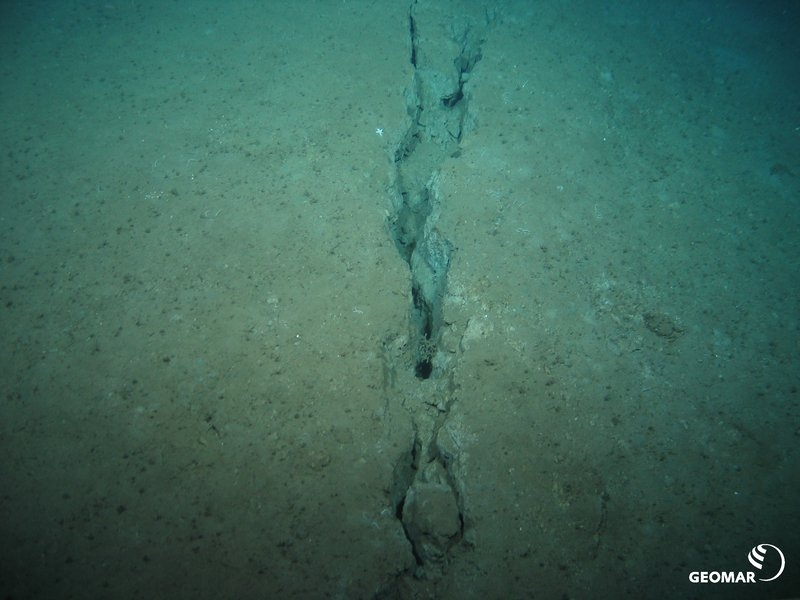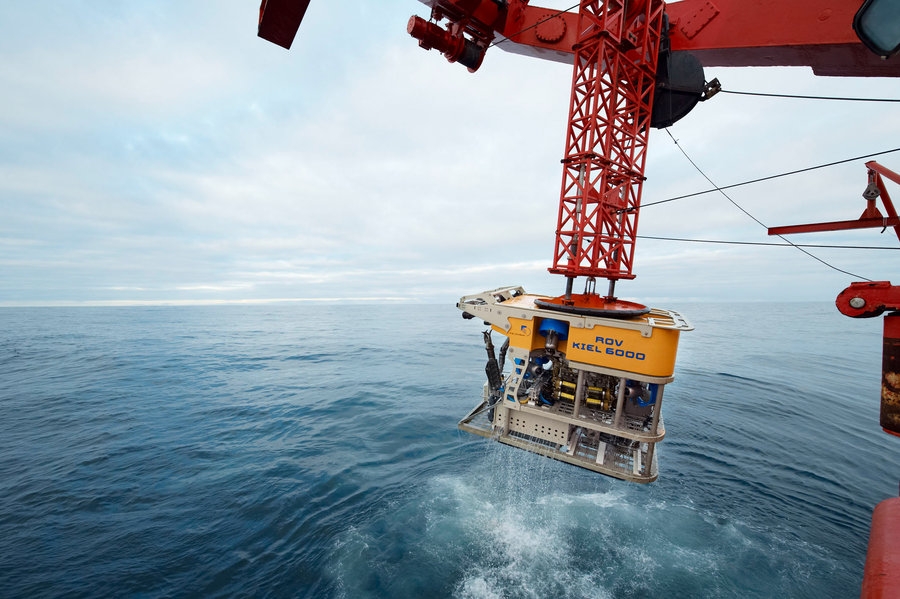
© Pictures taken by the remotely operated vehicle ROV KIEL 6000 in September 2010 show fresh traces of the Maule earthquake at the seabed.
(c) ROV-Team, GEOMAR

© The remotely operated vehicle ROV KIEL 6000 being lifted on board the research vessel SONNE after a dive to the Chilean subduction zone.
(c) Bernd Grundmann, GEOMAR
Earthquake gives rise to methane seepage at seafloor
December 20, 2016
Researchers publish findings after studying aftermath of 2010 earthquake in Chile
Most severe earthquakes take place beneath the seafloor. For a long time, it has been assumed that they were responsible for creating pathways that allowed gases from the Earth's interior to seep into the seawater. Now, with observations from the 2010 Maule earthquake in Central Chile, complemented by subsequent geochemical analysis and geophysical modelling, the scientists from the GEOMAR Helmholtz Center for Ocean Research Kiel are now able to prove this connection.
On 27 February 2010, Chile was hit with a 8.8 magnitude earthquake, which triggered a tsunami that affected the coastal sections of Central Chile. It was one of the ten most powerful earthquakes ever measured. The number of victims was lower than what one would have expected from an earthquake of that magnitude. However, the property damage cost more than US$30 billion.
The earthquake became one of the best observed and the tremors were scientifically measured, as research teams from several countries (including a team from GEOMAR) had installed measuring devices in the region.
During an expedition on the SONNE research vessel months after the event, they were able to document the aftermath of the earthquake, using the remotely operated vehicle ROV KIEL 6000.
Based on their observations, the team from GEOMAR and The Cluster of Excellence "The Future Ocean" has published their findings of the resultant methane emissions from the seabed in the international Geochemistry, Geophysics, Geosystems journal.
They had proved that the Maule earthquake in 2010 had caused new gas seepage off the coast of Chile.
"A link between methanedischarge at the seabed and strong earthquakes has long been suspected, but it is difficult to prove. The affected seabeds are often several thousand metres deep and are hard to reach. Thanks to the data from 2010, we are now able to prove this," said lead author Dr Jacob Geersen in German.
The study was based mainly on data collected during the SONNE's expedition in September and October 2010. The expedition, which had actually been planned years earlier, led exactly to the region where the earthquake's epicentre had been seven months earlier. In addition, during the ROV KIEL 6000's excursions to the ocean depths, it recorded fresh cracks on the seabed.
"They hadobviously emerged during the quake, just seven months before our expedition. On a geological time scale, this is just a blink of an eye," explained co-author Dr Peter Linke from GEOMAR, who was then the expedition coordinator.
Using modern sensor technology, the team detected a very high methane content in the water around the cracks as early as 2010. More accurate analysis showed that the methane had originated not from the uppermost layers of the ocean, but the deeper areas of the Earth's crust.
The geophysical and geochemical data, the images from the ROV KIEL 6000, as well as the samples obtained by the authors, have been supplemented by geophysical stress calculations of the subsurface.
"The observations show that the earthquake has re-activated deep faults in the ground, which in turn serve as channels for methane," explained co-author Dr Florian Scholz from GEOMAR.
The study shows, on an international scale, that strong earthquakes play an important role in the formation of methane seepage at the seafloor and the transport of gases from deep within the Earth's crust up to the surface.
"However, moreexpeditions into earthquake regions are necessary before it is possible to tell how much gases are being released by tectonic processes, whether and how these processes vary over time, and whether the gases can reach the atmosphere," said Dr Geersen.
See here for further information
Link to the study